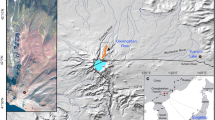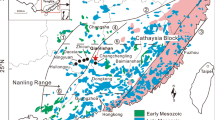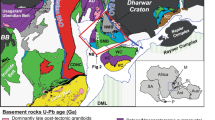Abstract
MASSIF-TYPE anorthosites and related rocks are an important component of the Grenville and Nain structural provinces of the Canadian Shield (Fig. 1), as well as in high grade metamorphic terrains in other parts of the world. There are many outstanding problems in the study of these rocks, not least of which is their age. Most geochronological data have been obtained from the associated granitic rocks of this suite as anorthosite itself contains very little rubidium and zirconium. Because of post-crystallisation deformation, however, the relationship between the anorthosite and the associated rocks is often tenuous and frequently disputed. Within the Grenville Province metamorphosed rocks believed to be genetically associated with anorthosites have yielded ages ranging from 1,020 to 1,130 Myr (refs 1–4). The high-grade of metamorphism surrounding the Morin and Lac St Jean anorthosites is believed by some researchers to be due to anorthosite emplacement. These ‘aureoles’ yield Rb–Sr ages5,6 of about 1,500 Myr. Anorthosite complexes in the Nain Province are undeformed, and the adamellite of the suite has yielded a U–Pb zircon age7 of about 1,300 Myr. Barton8 obtained a Rb–Sr isochron age of 1,418 Myr from a digested inclusion in the Nain anorthosite. Here we present geochronological data from the undeformed Sept Iles anorthosite, and show it to be Cambrian in age.
This is a preview of subscription content, access via your institution
Access options
Subscribe to this journal
Receive 51 print issues and online access
$199.00 per year
only $3.90 per issue
Buy this article
- Purchase on Springer Link
- Instant access to full article PDF
Prices may be subject to local taxes which are calculated during checkout
Similar content being viewed by others
References
Hills, A. & Gast, W., Bull. geol. Soc. Am. 75, 759–766 (1964).
Heath, S. A. & Fairbairn, H. W. New York State Mus. Sci. Serv. Mem. 18, 99–106 (1969).
Silver, L. T. New York State Mus. Sci. Serv. Mem. 18, 233–251 (1969).
Barton, J. M. & Doig, R., Can. J. Earth Sci. 9, 1180–1186 (1972).
Barton, J. M. & Doig, R., Am. J. Sci. 273, 376–384 (1973).
Frith, R. A. & Doig, R., Can. J. Earth Sci. 10, 881–899 (1973).
Krogh, T. E. & Davis, G. L. Carnegie Inst. Washington Yearbook, 72, 610–613 (1973).
Barton, J. M. Univ. Massachusetts Geol. Dept. Contrib. 13, 18–33 (1974).
Doig, R. & Barton, J. M., Can. J. Earth Sci. 5, 1401–1407 (1968).
Wynne-Edwards, H. R. Geol. Ass. Can. Sp. Paper 11, 263–333 (1972).
Doig, R. Can. J. Earth Sci. 7, 22–28 (1970).
Author information
Authors and Affiliations
Rights and permissions
About this article
Cite this article
HIGGINS, M., DOIG, R. 540-Myr-old anorthosite complex in the Grenville Province of Quebec, Canada. Nature 267, 40–41 (1977). https://doi.org/10.1038/267040a0
Received:
Accepted:
Issue Date:
DOI: https://doi.org/10.1038/267040a0
Comments
By submitting a comment you agree to abide by our Terms and Community Guidelines. If you find something abusive or that does not comply with our terms or guidelines please flag it as inappropriate.



